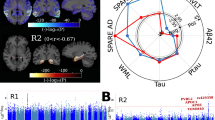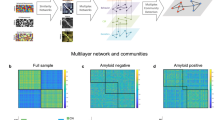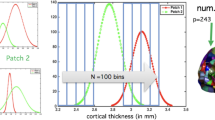Abstract
Recent advancements in medicine have confirmed that brain disorders often comprise multiple subtypes of mechanisms, developmental trajectories, or severity levels. Such heterogeneity is often associated with demographic aspects (e.g., sex) or disease-related contributors (e.g., genetics). Thus, the predictive power of machine learning models used for symptom prediction varies across subjects based on such factors. To model this heterogeneity, one can assign each training sample a factor-dependent weight, which modulates the subject’s contribution to the overall objective loss function. To this end, we propose to model the subject weights as a linear combination of the eigenbases of a spectral population graph that captures the similarity of factors across subjects. In doing so, the learned weights smoothly vary across the graph, highlighting sub-cohorts with high and low predictability. Our proposed sample weighting scheme is evaluated on two tasks. First, we predict initiation of heavy alcohol drinking in young adulthood from imaging and neuropsychological measures from the National Consortium on Alcohol and NeuroDevelopment in Adolescence (NCANDA). Next, we detect Dementia vs. Mild Cognitive Impairment (MCI) using imaging and demographic measurements in subjects from the Alzheimer’s Disease Neuroimaging Initiative (ADNI). Compared to existing sample weighting schemes, our sample weights improve interpretability and highlight sub-cohorts with distinct characteristics and varying model accuracy.
Access this chapter
Tax calculation will be finalised at checkout
Purchases are for personal use only
Similar content being viewed by others
References
Adeli, E., Shi, F., An, L., Wee, C.Y., Wu, G., Wang, T.: Joint feature-sample selection and robust diagnosis of Parkinson’s disease from MRI data. NeuroImage 141, 206–219 (2016)
Belloy, M.E., et al.: Association of Klotho-VS heterozygosity with risk of Alzheimer disease in individuals who carry APOE4. JAMA Neurol. 77(7), 849–862 (2020)
Brown, S.A., et al.: The National Consortium on Alcohol and Neurodevelopment in Adolescence (NCANDA): a multisite study of adolescent development and substance use. J. Stud. Alcohol Drugs 76(6), 895–908 (2015)
Cho, K., et al.: Learning phrase representations using RNN encoder-decoder for statistical machine translation. arXiv preprint arXiv:1406.1078 (2014)
Chung, F.: Spectral Graph Theory. American Mathematical Society, Providence, R.I. (1997)
Collins, S.: Associations between socioeconomic factors and alcohol outcomes. Alcohol Res. Curr. Rev. 38, 83–94 (2016)
Dhamala, E., Jamison, K.W., Jaywant, A., Kuceyeski, A.: Shared functional connections within and between cortical networks predict cognitive abilities in adult males and females. Human Brain Mapp. 43, 1087–1102 (2022). https://pubmed.ncbi.nlm.nih.gov/34811849/
Dhamala, E., Yeo, B., Holmes, A.: One size does not fit all: methodological considerations for brain-based predictive modeling in psychiatry. Biol. Psychiatry 93, 717–728 (2022)
Dir, A., Bell, R., Adams, Z., Hulvershorn, L.: Gender differences in risk factors for adolescent binge drinking and implications for intervention and prevention. Front. Psychiatry 8, 289 (2017)
Drysdale, A.T., et al.: Resting-state connectivity biomarkers define neurophysiological subtypes of depression. Nat. Med. 23(1), 28–38 (2017)
Greene, A., et al.: Brain-phenotype models fail for individuals who defy sample stereotypes. Nature 609, 1–10 (2022)
Hartig, M., et al.: UCSF freesurfer methods. ADNI Alzheimers Disease Neuroimaging Initiative, San Francisco, CA, USA (2014)
James, G., Witten, D., Hastie, T., Tibshirani, R., et al.: An Introduction to Statistical Learning, vol. 112. Springer, Cham (2013). https://doi.org/10.1007/978-3-031-38747-0
Jiang, L., Meng, D., Zhao, Q., Shan, S., Hauptmann, A.: Self-paced curriculum learning. In: Proceedings of the AAAI Conference on Artificial Intelligence, vol. 29 (2015)
Jiang, L., Zhou, Z., Leung, T., Li, L.J., Fei-Fei, L.: MentorNet: learning data-driven curriculum for very deep neural networks on corrupted labels. In: International Conference on Machine Learning, pp. 2304–2313. PMLR (2018)
Jiang, R., et al.: Gender differences in connectome-based predictions of individualized intelligence quotient and sub-domain scores. Cereb. Cortex 30, 888–900 (2019)
Liu, E.Z., et al.: Just train twice: improving group robustness without training group information. In: International Conference on Machine Learning, pp. 6781–6792. PMLR (2021)
Mendez, M.F.: Early-onset Alzheimer disease and its variants. Continuum (Minneapolis, Minn.) 25(1), 34 (2019)
Paschali, M., et al.: Detecting negative valence symptoms in adolescents based on longitudinal self-reports and behavioral assessments. J. Affect. Disord. 312, 30–38 (2022)
Petersen, R.C., et al.: Alzheimer’s disease neuroimaging initiative (ADNI): clinical characterization. Neurology 74(3), 201–209 (2010)
Pfefferbaum, A., et al.: Altered brain developmental trajectories in adolescents after initiating drinking. Am. J. Psychiatry 175(4), 370–380 (2017)
Podcasy, J.L., Epperson, C.N.: Considering sex and gender in Alzheimer disease and other dementias. Dialogues Clin. Neurosci. 18(4), 437–446 (2016)
Pohl, K., et al.: Harmonizing DTI measurements across scanners to examine the development of white matter microstructure in 803 adolescents of the NCANDA study. Neuroimage 130, 194–213 (2016)
Ren, M., Zeng, W., Yang, B., Urtasun, R.: Learning to reweight examples for robust deep learning. In: International Conference on Machine Learning, pp. 4334–4343. PMLR (2018)
Roh, Y., Lee, K., Whang, S.E., Suh, C.: Sample selection for fair and robust training. In: Neural Information Processing Systems (NeurIPS) (2021)
Santiago, C., Barata, C., Sasdelli, M., Carneiro, G., Nascimento, J.C.: LOW: training deep neural networks by learning optimal sample weights. Pattern Recogn. 110, 107585 (2021)
Saykin, A.J., et al.: Alzheimer’s disease neuroimaging initiative biomarkers as quantitative phenotypes: genetics core aims, progress, and plans. Alzheimer’s Dement. 6(3), 265–273 (2010)
Tschorn, M., et al.: Differential predictors for alcohol use in adolescents as a function of familial risk. Transl. Psychiatry 11, 157 (2021)
Zhao, Q., et al.: Identifying high school risk factors that forecast heavy drinking onset in understudied young adults. Dev. Cogn. Neurosci. 68, 101413 (2024)
Acknowledgements
This work was supported by the U.S. National Institute (DA057567, AA021697, AA010723, AA028840), BBRF Young Investigator Grant, the DGIST Joint Research Project, the 2024 HAI Hoffman-Yee Grant, and the HAI-Google Cloud Credits Award. The NCANDA data were based on a formal, locked data release NCANDA_NIAAADA_BASE_V01, NCANDA_NIAAADA_01Y_V01 to NCANDA_NIAAADA_07Y_V01 available via https://nda.nih.gov/edit_collection.html?id=4513. NCANDA data collection and distribution were supported by NIH funding AA021681, AA021690, AA021691, AA021692, AA021695, AA021696, AA021697.
Author information
Authors and Affiliations
Corresponding author
Editor information
Editors and Affiliations
Rights and permissions
Copyright information
© 2025 The Author(s), under exclusive license to Springer Nature Switzerland AG
About this paper
Cite this paper
Paschali, M. et al. (2025). Spectral Graph Sample Weighting for Interpretable Sub-cohort Analysis in Predictive Models for Neuroimaging. In: Rekik, I., Adeli, E., Park, S.H., Cintas, C. (eds) Predictive Intelligence in Medicine. PRIME 2024. Lecture Notes in Computer Science, vol 15155. Springer, Cham. https://doi.org/10.1007/978-3-031-74561-4_3
Download citation
DOI: https://doi.org/10.1007/978-3-031-74561-4_3
Published:
Publisher Name: Springer, Cham
Print ISBN: 978-3-031-74560-7
Online ISBN: 978-3-031-74561-4
eBook Packages: Computer ScienceComputer Science (R0)





